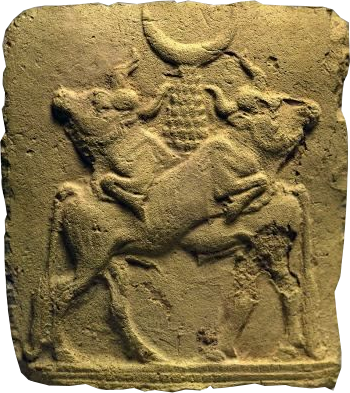Ancient Psychedelia: Alien Gods & Mushroom Goddesses
Online Book - Chapter 8, Page 110
Back to Online Book Mainpage / Next Page (Chapter 8, Page 111)
 (14f) Baal-Adad Israel Museum, Jerusalem c. 1500 BC In the Enūma Elišh, Girra (in the form Gibil), is listed as one of the fifty aspects of Marduk. (44) The only iconography we have for Girra is from text, as a torch. (45) In the following Hymn to Kusu, we read about the “great bull Enki,” the “god of fire Gibil” and an oven with bulls and sheep placed in them. All of this is very reminiscent of the Rig Veda as well. What is the mention of sheep wool for? The sheep’s wool always appears to represent A. muscaria, as we saw earlier. The bull is always representative of the dung from which the mushrooms grow. And also, important to note is the affiliation of water=teat’s milk: (1-8) O angry great butting bull! O torch! O great bull of Enki, standing aggressively, coming forth from the abzu, the pure place! O Gibil (the god of fire), … the palace and hall, as he radiates great awesomeness, his countenance ……! O Nun-bar-ana, angry avenger (?) …, bringing forth the great torch from the abzu, lifting his head with the noble divine powers! (9-19) O antler-like horn of a mountain goat! Cedar, cypress, juniper and boxwood, white wool and black wool, white birch and black birch, a string of apples tied to a long string of figs, butter flowing from the holy cattle-pen and sheepfold …… in the oven and purified by the torch, … reeds are tied up and lit … (2 lines fragmentary) (20-6) In their … Kusu has consecrated the ……, she has purified the oven. , … Kusu has then put numerous bulls and numerous sheep into the great oven. Kusu has then put numerous bulls and numerous loaves into the great oven. (27-33) Destiny, prosperity -- the wood of destiny, wood of prosperity, and the reeds of destiny, reeds of prosperity, adorn the holy cattle-pen. Through the wool from a fair lamb and the wool from a fair kid, Gibil, the foremost, the right arm, lifting his head to heaven receives water from the holy teats of heaven. (34-39) This water consecrates the heavens, it purifies the earth. It purifies the cattle in their pen. It purifies the sheep in their fold. It purifies Utu at the horizon. It purifies Nanna at the zenith of heaven. (46) |
The Appeal to Gibil was for the purpose of purification and cleansing. This was an internal act as the eating of a sacrament. The “bulls and loaves were placed into the great oven.” At this stage, this was already likened to “loaves of bread from heaven,” like the Manna we read about in the Old Testament. It could be said that Gibil was a mediator (angel) between Ea and the sick. (47) Gibil was also a healing deity and later assimilated to Nusku and sometimes to Nabu. (48) In the Sumerian account of the flood, Ziusudra was the original Noah, and Enki plays the role of God, who tells Ziusudra to build a boat, give up his possessions, take the seeds of every living being and prepare for the coming flood. Though the mushroom symbolism is not strong in early flood myth, the deities involved all relate to elements of the earth and sky, the rain and wind, and the storm from the goddesses and gods in heaven. Storms always bring mushrooms with the rain and wind. What we also find present is the “seer” in relation to kingship. The king is a visionary, a shaman. (44) see Tablet VII, line 115 in Foster 2005: 482 (45) see for example Šurpû, Tablet IX lines 107-118 in Conti 2000: 128-30; http://oracc.museum.upenn.edu/amgg/listofdeities/girra/index.html (46) A hymn to Kusu (Kusu A); http://etcsl.orinst.ox.ac.uk/cgi-bin/etcsl.cgi?text=t.4.33.2# (47) Healing Gods, p. 121; Jastrow, Civilization of Babylonia and Assyria, Philadelphia, 1915 (48) ibid, 121; Jastrow, The Religion of Babylonia and Assyria, p. 220 |
Go Back to Page 109